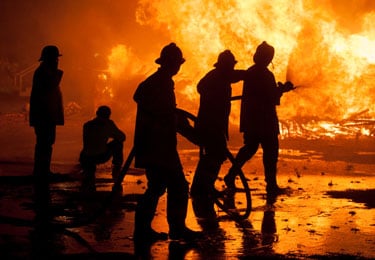Firefighter Resources – Job Hazards
Job Hazards

Structural and vehicle fires involve different types of exposures and hazards. Exposure and risk levels depend on building material, materials stored within, and fire conditions, such as temperature and oxygen availability.
The phase of a fire can also influence exposure level. The knockdown phase typically has higher exposure to heated gas, vapors, and particulate matter compared to overhaul. Respiratory protection is more likely to be worn during knockdown than during the overhaul phase, even though lower level exposures may still exist during this phase.
Publications
- Contamination of firefighter personal protective equipment and skin and the effectiveness of decontamination procedures (2017) (open access)
- IFSI Research Supplement: Introducing the 10 considerations related to cardiovascular and chemical exposure risks (2017)
- Volatile organic compounds off-gassing from firefighters’ personal protective equipment ensembles after use (2015)
- Firefighter’s perspective on flame retardants (2015)
- Off-Gassing Contaminants from firefighters’ personal protective equipment (2015)
- Simulated smoke, real health effects (2014)
- Systemic exposure to PAHs and benzene in firefighters suppressing controlled structure fires (2014) (open access)
- Evaluation of dermal exposure to polycyclic aromatic hydrocarbons in firefighters Health Hazard Evaluation Report: No. 2010-0156-3196 (2013) Summary Report
- Evaluation of chemical exposures during firefighter training exercises involving smoke simulant Health Hazard Evaluation Report: No. 2012-0028-3190 (2013)
- Evaluation of carbon monoxide exposures during rescue operations using personal watercraft – Florida (Miami) Health Hazard Evaluation Report: No. 2008-0014-3151 (2012)
- Assessing the risk to firefighters from chemical vapors and gases during vehicle fire suppression (2011)
- Controlling diesel exhaust exposure inside firehouses (2011)
- Chemical and particle exposures during vehicle fire suppression training, Miami Township Fire and Rescue, Yellow Springs, OH Health Hazard Evaluation Report: No. 2008-0241-3113 (2010)
- Evaluation of carbon monoxide exposures in the Bridgewater Channel in Lake Havasu, AZ Health Hazard Evaluation Report: No. 2002-0393-2928 (2004)
- Biomarkers of smoke exposure among firefighters (2001)
- Evaluation of diesel exhaust controls, Costa Mesa, CA Health Hazard Evaluation Report: No. 99-0266-2850 (2001)
- Characterization of firefighter exposures during fire overhaul (2000)
- Evaluation of American Ref-fuel incident, Newark, NJ Health Hazard Evaluation Report: No. 99-0062-2804 (2000)
- International Association of Firefighters, Indianapolis, IN Health Hazard Evaluation Report: No. 97-0034-2683 (chemical exposure, hazardous materials) (1998)
- International Association of Firefighters, Henderson, NV Health Hazard Evaluation Report: No. 91-0230-2543 (chlorine gas exposure) (1995)
- International Association of Firefighters, Jersey City, NJ Health Hazard Evaluation Report: No. 91-0190-2491 (methylene chloride exposure, hazardous materials) (1995)
- Valdosta Fire Department, Valdosta, GA Health Hazard Evaluation Report: No. 95-0047-2485 (chemical exposure, hazardous materials) (1995)
- North Riverside Fire Department, North Riverside, IL Health Hazard Evaluation Report: No. 87-109-1950 (zinc chloride exposure, injury) (1989)
- Evaluation zinc chloride smoke generating devices, Washington, D.C. Health Hazard Evaluation Report: No. 85-274-1879 (1988)
- Liquid Disposal Inc., Shelby Township, MI Health Hazard Evaluation Report: No. 83-326-1535 (exposure to dioxin) (1984)
- NIOSH testimony on polychlorinated biphenyls (PCBs): Manufacture, processing, distribution in commerce and use prohibitions: Use in transformers (1984)
- Firefighters’ occupational exposure to carbon monoxide (1974)
Emergency Response Hazards
- Hurricane Katrina response Health Hazard Evaluation Report: No. 2005-0369-3034 (2007)
- A multidimensional evaluation of firefighter training for hazardous materials response: first results from the IAFF program (1998)
Fire-Damaged Floor
- Preventing deaths and injuries of firefighters working above fire-damaged floors Workplace Solutions: No. 2009-114 (2009) Español
- Preventing injuries and deaths of firefighters due to truss system failures NIOSH Alert: No. 2005-132 (2005)
Job Stress
- New Orleans Fire Department, hurricane-related issues Health Hazard Evaluation Report: No. 2006-0023-3003 (2006)
- Outcomes of a leadership intervention for a metropolitan fire department (2001)
- Anaheim Fire Department, Anaheim, CA Health Hazard Evaluation Report: No. 94-0390-2822 (2000)
- Psychosocial risk factors in firefighter stress (1999)
- Exposure to traumatic incidents and prevalence of posttraumatic stress symptomatology in urban firefighters in two countries (1999)
- Exposure to duty-related incident stressors in urban firefighters and paramedics (1998)
- Social support and network conflict in firefighters and paramedics (1997)
Other
- Preventing Death and Injuries of FireFighters Operating Modified Excess/Surplus Vehicles Workplace Solutions: No. 2011-125 (2011) Español
- Biological monitoring of woodsmoke (2005)
- Preventing deaths and injuries to firefighters during live-fire training in acquired structures Workplace Solutions: No. 2005-102 (2005) Español
- Divers beware: training dives present serious hazards to firefighters Workplace Solutions: No. 2004-152 (2004) Español
- Project HEROES (Homeland Emergency Response Operational and Equipment Systems) Task 1: A review of modern fire service hazard and protection needs (2003)
- Occupational noise exposure and hearing loss in firefighters assigned to airport fire stations (1991)
- Industrial process – firefighting (1978)
